This morning I needed a little Burrowing Owl silliness.
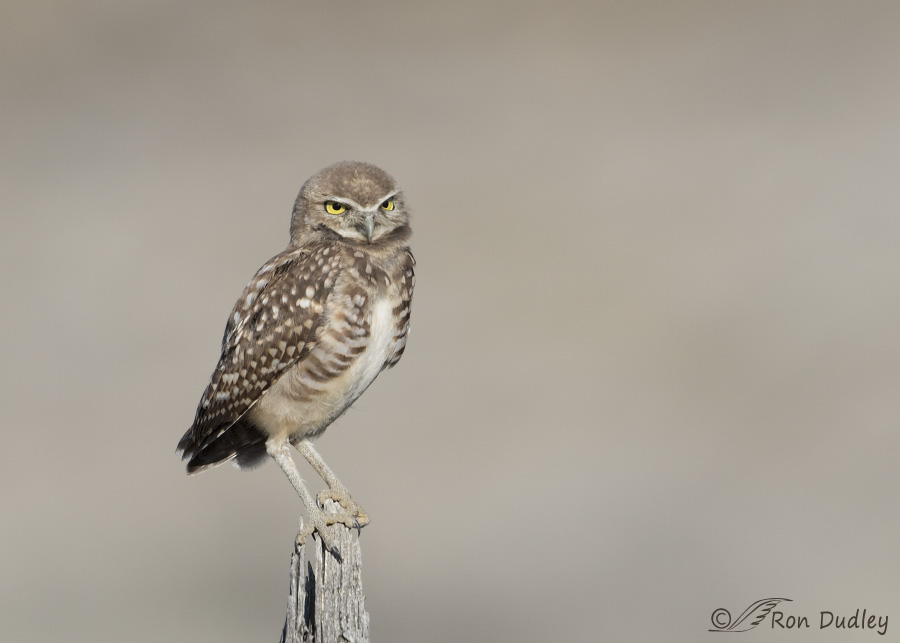
1/3200, f/7.1, ISO 500, Canon 7D Mark II, Canon EF 500mm f/4L IS II USM + 1.4 tc, not baited, set up or called in
I photographed this juvenile (and its siblings) this past July in a remote area of Box Elder County. Like most youngsters of the species they were amusing to watch. They experimented with their environment, their siblings and themselves as they learned about the world they found themselves in. They could sometimes look pretty serious but it never lasted long.
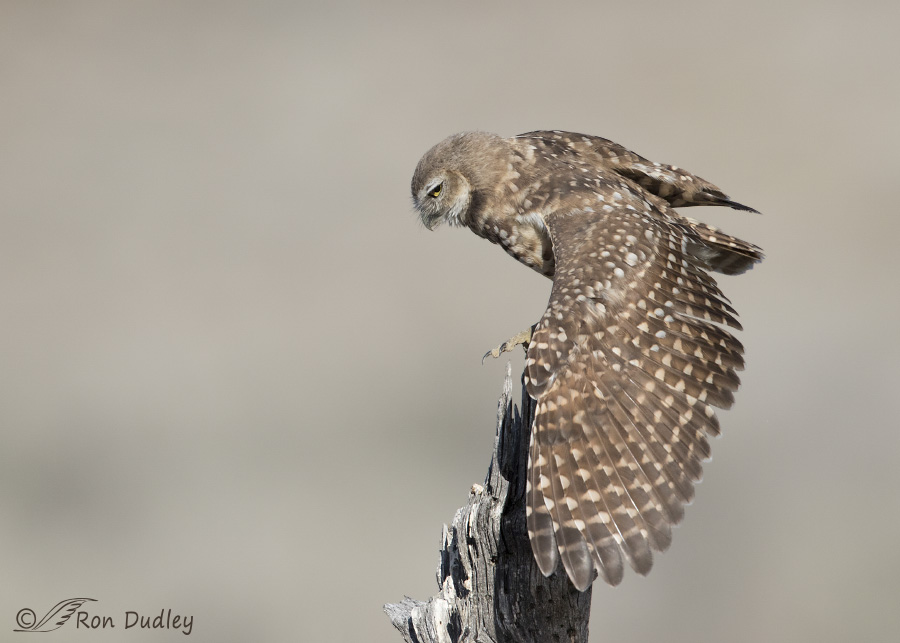
1/2500, f/7.1, ISO 500, Canon 7D Mark II, Canon EF 500mm f/4L IS II USM + 1.4 tc, not baited, set up or called in
I never knew what might happen when they tried to stretch on an elevated perch because they were so awkward and clumsy. They would often lose their balance and then have to use their wings to recover so I had to be prepared with enough shutter speed and depth of field to capture unpredictable poses as well as I could.
This time the bird didn’t lose its balance but I got a nice wing stretch in my direction and I also enjoy the stretching foot in front of the wing. This youngster did unusually well because it was obviously balanced on one foot during the stretch and never did begin to fall.
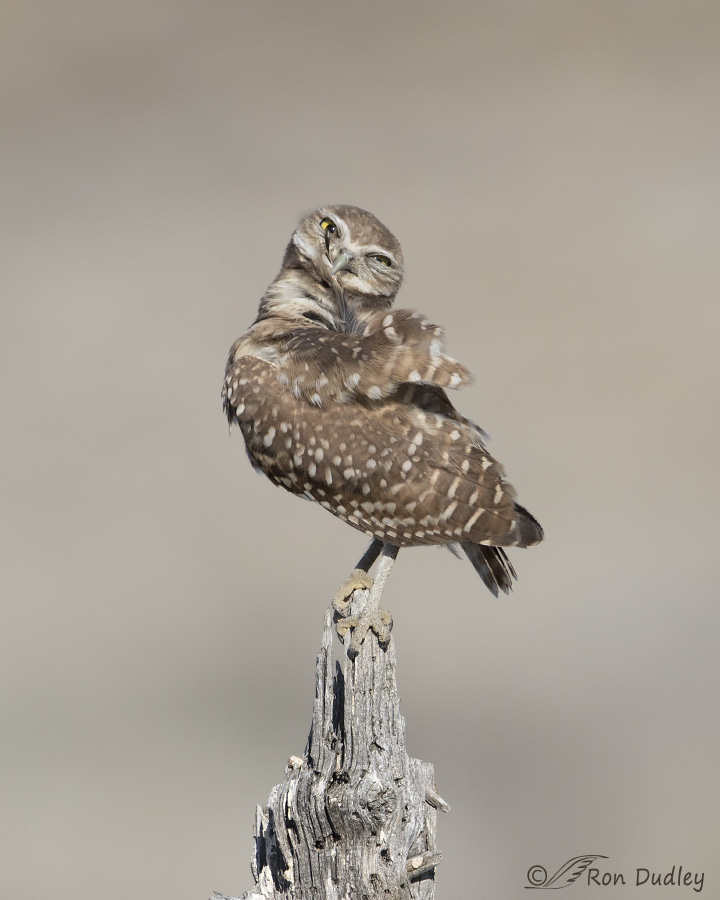
1/3200, f/7.1, ISO 500, Canon 7D Mark II, Canon EF 500mm f/4L IS II USM + 1.4 tc, not baited, set up or called in
Then it turned on the post and began to preen. These kinds of activities on an elevated perch are difficult for young owls for reasons of stability but it’s how they learn and develop. Those talons almost look like they have a death-grip on the perch in order to prevent the bird from losing its balance. It’s a silly pose but I like silliness from Burrowing Owls, especially juveniles.
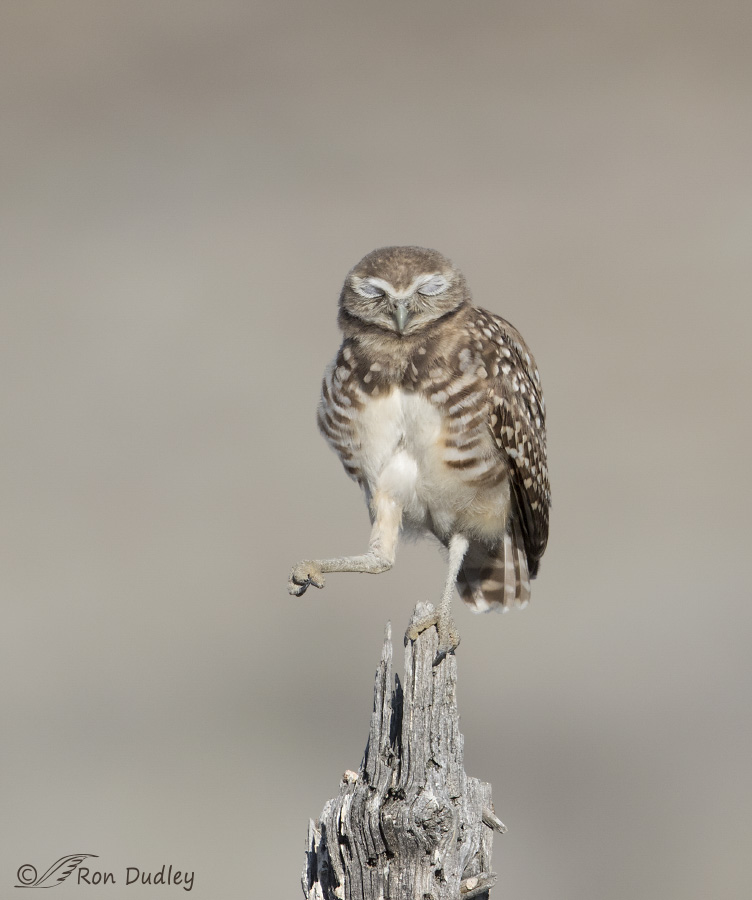
1/3200, f/7.1, ISO 500, Canon 7D Mark II, Canon EF 500mm f/4L IS II USM + 1.4 tc, not baited, set up or called in
Then the bird really turned on the goofy-juice. This is a pose I’ve seen often from raptors (I don’t know why I never see it in other birds) but I’m really not sure what’s happening – perhaps it’s a foot clenching exercise. The pose is often held for some time and with its eyes closed it looks like this youngster is enjoying the moment.
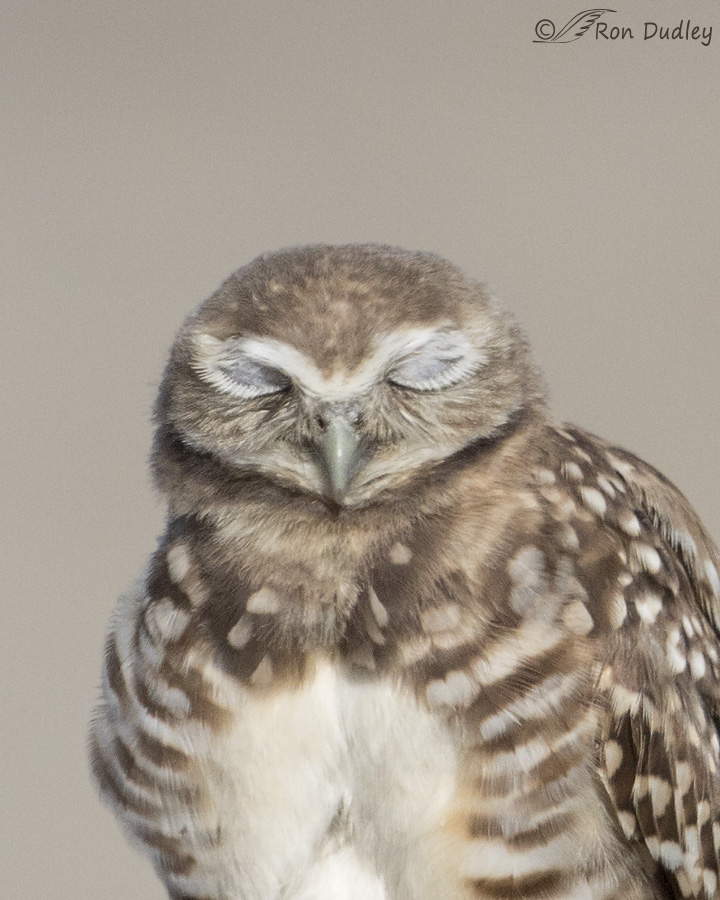
A huge crop (only 5% of the original image) of the previous photo gives us a better look at those eyelids and amazing “eyelashes”. Owls lower their upper eyelids when blinking but raise their lower eyelids when asleep.
I’ve often wondered if the long eyelashes and bushy eyebrows of Burrowing Owls might be adaptations designed to help keep dirt out of their eyes while they’re in their burrows.
For the past few weeks I’ve been seeing Burrowing Owls on Antelope Island which is quite unusual in the dead of winter. I hope that’s an encouraging sign because in much of the west these birds are really struggling.
Ron


I love these little guys. They are beautiful, cute, silly and serious all rolled into one. Thanks for the great photos Ron.
What a neat study on this little guy. Goodness, the lashes!
Wonderful series Ron!
Charlotte
This cheered me up. I’ve had a rather excrement-full day today (had to take a lost dog to the animal shelter which broke my heart.). I needed this silliness as well.
Oooooh.
Too many Burrowing Owls would be barely enough.
A lovely, lovely smile filled start to a day which is likely to be challenging.
Megathanks.
“Too many Burrowing Owls would be barely enough.”
You do have a way with words, EC. That reminded me of another clever line I read just this morning. Truman Capote wrote this about Babe Paley (Bill Paley’s wife) – “Mrs P. had only one fault: she was perfect. Otherwise she was perfect”.
Doesn’t take much to amuse me I guess…
Thanks for another wonderful Burrowing Owl fix…these are so darned cute and funny!….They always mske me smile, often make me laugh out loud and always brighten my day. The idea of a world without them is unthinkable…What a terrible tradgedy that would be! I love the shot of this funny little fellow doing talon-clenching isometrics…..
I wish I could paper a wall with images of Burrowing Owls…it would keep me smiling all day long!!’
Patty, you were on my mind when I chose these images. I deliberately avoided any that included barbed wire…
Thank you!!!
I just love burrowing owls! Now there’s a surprise 😀 And what lovely images–standing WOW! Burrowing owls rushed to the front of the “goofy-juice” line and slurped it up like it was their favorite rodent-flavored candy!
I’m a little shocked that I can’t find a word for that foot stretch with the foot clenching. Arcane falconry language seems to have a word for everything else, but not that.
And I’ve often wondered if raptors meditate. It so often looks as though they do.
“I’m a little shocked that I can’t find a word for that foot stretch with the foot clenching”
Ha, finally stumped you on that one, Laura. Can’t remember that happening before! I’m also really curious why that pose is (at least in my experience) limited to raptors. So many mysteries…
Indeed Ron, and that’s why I’m flummoxed about the lack of a term in ancient falconry language–well, I haven’t found it yet. Maybe I should go back and read ALL of the Shakespeare’s work again, starting with “Taming of the Shrew.” Falconers have often said that was the story of training an adult female goshawk, which gives a whole ‘nother layer of understanding to that work. If there is a word for it, and I can’t believe there’s not, it would be in his works somewhere.
Loved these little guys, and especially the eyelids/eyelashes note–I’ll bet your surmise on the adaptation is correct…
“I’ll bet your surmise on the adaptation is correct”
If anyone knows for sure I hope they’ll enlighten us, Kris.
Wonderful post! I love these birds and any chance to see them is a treat! They are nearly extirpated in my area, alas.
“They are nearly extirpated in my area”
I’m sorry to hear that, Christina but sadly it doesn’t surprise me.
Great pictures, Ron – they certainly do have a lot of maneuvers! 🙂 The clenched claw and closed eyes almost look like it’s meditating. Was unaware of the upper/lower eyelid differences. Amazing and fun creatures!
A meditating owl, now there’s an interesting thought, Judy!
A great post per usual. I love these little guys, but have never had the opportunity to see them in a natural setting. Thanks
Thanks, Sharon. They’re the most entertaining birds I know of.